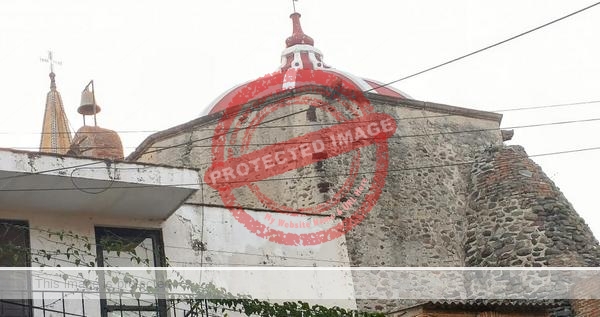Two young US artists—Everett Gee Jackson and Lowell Houser—who had first met at art school in Chicago, arrived in Chapala in 1923. Apart from short trips elsewhere they spent the next three and a half years at Lake Chapala—living first in Chapala, then in Ajijic, and then returning once again to Chapala—before continuing their highly successful art careers elsewhere. They are two of the earliest US painters to spend any significant amount of time sketching and painting at Lake Chapala.
Painted about one hundred years ago, this painting by Everett Gee Jackson was one of several early paintings included in a major retrospective of his work held at the San Diego Art Museum in 2007. According to the catalog of that exhibition, the painting (in a private collection) is titled “Church in Chapala.”

Everett Gee Jackson. c 1924. Church in Chapala. Credit: “Everett Gee Jackson/San Diego Modern, 1920-1955.”
But is this title accurate? The only church in Chapala in the 1920s was the parish church of San Francisco (La Parroquía de San Francisco), which has distinctive twin towers. My first thought was that this painting does not appear to match that church. Nor does it look like the churches in neighboring San Antonio Tlayacapan or Ajijic. So, is it really one of the churches at Lake Chapala, or does it depict a church elsewhere, perhaps in Guanajuato?

Dale Palfrey. View of San Francisco Church, Chapala, April 2024.
Asking this question online attracted a variety of responses, some supporting Chapala and others Guanajuato. Now, my good friend Dale Palfrey has kindly sent me photos taken from the presumed vantage point of the artist in Chapala, which establish beyond doubt that the painting does indeed depict the east end of San Francisco church in Chapala.
The foreground building in the photograph is modern, and obscures the original beautiful view enjoyed by D. H. Lawrence, Witter Bynner, Everett Gee Jackson and all the other famous visitors to Chapala in the 1920s.
Several chapters of Foreign Footprints in Ajijic: Decades of Change in a Mexican Village offer more details about the history of the artistic community in Ajijic. For the history of numerous buildings in Chapala, including the main church, see If Walls Could Talk: Chapala’s Historic Buildings and Their Former Occupants, translated into Spanish as Si las paredes hablaran: Edificios históricos de Chapala y sus antiguos ocupantes.
Source
-
- D. Scott Atkinson. 2007. Everett Gee Jackson: San Diego Modern, 1920-1955. San Diego Museum of Art.
Comments, corrections and additional material are welcome, whether via the comments feature or email.
Tony Burton’s books include “Lake Chapala: A Postcard History” (2022), “Foreign Footprints in Ajijic” (2022), “If Walls Could Talk: Chapala’s historic buildings and their former occupants” (2020), (available in translation as “Si Las Paredes Hablaran”), “Mexican Kaleidoscope” (2016), and “Lake Chapala Through the Ages” (2008).